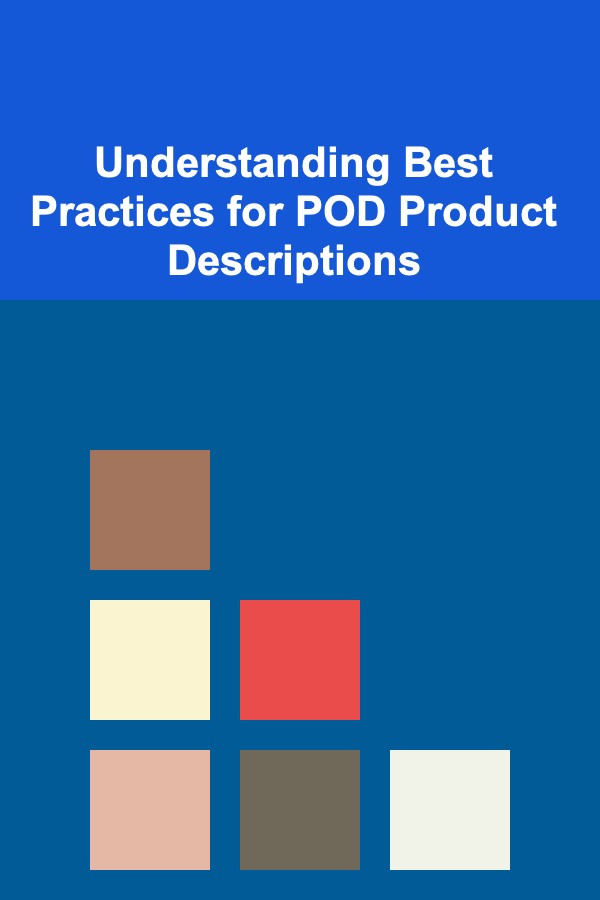
Understanding Best Practices for POD Product Descriptions
ebook include PDF & Audio bundle (Micro Guide)
$12.99$5.99
Limited Time Offer! Order within the next:

In the dynamic world of e-commerce, Print on Demand (POD) has emerged as a popular business model, offering entrepreneurs and creatives a low-risk entry point to selling customized products. One of the critical factors determining the success of a POD venture is the effectiveness of its product descriptions. A well-crafted product description not only informs potential customers about what they're buying but also persuades them to make a purchase. This comprehensive guide delves deep into the best practices for creating compelling and effective product descriptions for POD products, covering everything from understanding your target audience to optimizing for search engines.
The Importance of Effective Product Descriptions in POD
Product descriptions are often the first point of contact a customer has with your product beyond the visual image. They serve several crucial functions:
- Informing Customers: The primary function is to provide accurate and detailed information about the product, including its features, materials, size, and care instructions.
- Persuading Customers: Beyond mere information, a good description highlights the benefits of the product and why it's the best choice for the customer's needs.
- Improving SEO: Optimized descriptions incorporate relevant keywords that help search engines like Google understand and rank your product pages.
- Reducing Returns: Clear and accurate descriptions minimize misunderstandings and misinterpretations, leading to fewer returns and happier customers.
- Building Trust: Honest and transparent descriptions build trust with your audience, establishing you as a reliable seller.
- Enhancing Brand Image: The tone, style, and language used in product descriptions contribute to your overall brand image and personality.
Understanding Your Target Audience
Before you start writing, it's essential to have a clear understanding of your target audience. Consider the following questions:
- Who are they? What are their demographics (age, gender, location, income, education)?
- What are their interests and values? What motivates them? What are they passionate about?
- What are their needs and pain points? What problems are they trying to solve?
- What kind of language do they use? Are they formal or informal? Do they use slang or jargon?
- What are their purchasing habits? Are they price-sensitive? Do they value quality and durability?
The answers to these questions will inform the tone, style, and content of your product descriptions. For example, a product targeted at Gen Z might use a more casual and humorous tone, while a product targeted at professionals might use a more formal and sophisticated tone.
Key Elements of a High-Converting POD Product Description
A compelling POD product description typically includes the following key elements:
1. Compelling Headline
The headline is the first thing customers see, so it needs to be attention-grabbing and informative. It should clearly state what the product is and highlight its key benefit. Consider these examples:
- Weak Headline: T-Shirt
- Better Headline: Premium Cotton T-Shirt - Comfortable and Stylish
- Best Headline: "Adventure Awaits" Graphic T-Shirt - Soft, Durable, and Perfect for Explorers
The best headline is specific, highlights a key benefit (perfect for explorers), and uses relevant keywords (graphic t-shirt).
2. Engaging Opening Paragraph
The opening paragraph should immediately capture the reader's attention and create a desire for the product. Consider these strategies:
- Start with a problem: "Tired of uncomfortable t-shirts that shrink after the first wash?"
- Tell a story: "Imagine yourself hiking through the mountains, feeling the soft cotton of this t-shirt against your skin..."
- Highlight a key benefit: "Experience ultimate comfort and style with our premium cotton t-shirt."
The goal is to hook the reader and make them want to learn more.
3. Detailed Features and Benefits
This section should provide a comprehensive list of the product's features and, more importantly, explain the benefits of those features. Remember, customers are more interested in what the product can do for them than in the technical specifications.
Example:
- Feature: 100% Premium Ringspun Cotton
- Benefit: Experience unparalleled softness and breathability, keeping you comfortable all day long.
- Feature: Double-Needle Stitched Hems
- Benefit: Enjoy exceptional durability and a long-lasting fit, wash after wash.
- Feature: Unique and Vibrant Print
- Benefit: Express your individuality with a design that's guaranteed to turn heads.
Notice how each feature is followed by a clear and compelling benefit that resonates with the customer's needs and desires.
4. High-Quality Product Images and Videos
While not technically part of the written description, visuals are crucial for showcasing the product. Use high-resolution images that show the product from multiple angles and in different contexts. Consider adding a video that demonstrates the product's features and benefits in action.
5. Call to Action (CTA)
Every product description should end with a clear and compelling call to action. Tell customers exactly what you want them to do next.
Examples:
- "Add to Cart Now!"
- "Shop the Collection!"
- "Get Yours Today Before They're Gone!"
- "Personalize Your Own!"
Use strong action verbs and create a sense of urgency or excitement.
6. Size Chart and Fit Information
For apparel and other products that require sizing, include a detailed size chart with measurements in both inches and centimeters. Provide information about the fit (e.g., slim fit, relaxed fit, true to size) to help customers choose the right size.
7. Care Instructions
Clearly state the care instructions for the product to ensure its longevity. This is especially important for apparel and other textiles. For example:
"Machine wash cold, tumble dry low. Do not bleach. Iron inside out on low heat."
8. Shipping and Returns Information
Provide clear and concise information about shipping costs, delivery times, and return policies. Transparency in these areas builds trust and reduces customer anxiety.
9. Social Proof (Reviews, Testimonials)
If possible, include social proof in the form of customer reviews or testimonials. Positive reviews can significantly increase conversion rates.
Optimizing Product Descriptions for SEO
To ensure that your products are easily found by potential customers, it's essential to optimize your product descriptions for search engines. Here are some key strategies:
1. Keyword Research
Before you start writing, conduct thorough keyword research to identify the terms that your target audience is using to search for products like yours. Use tools like Google Keyword Planner, SEMrush, or Ahrefs to find relevant keywords with high search volume and low competition.
Example: If you're selling a mug with a cat design, you might research keywords like "cat mug," "funny cat mug," "cat lover gift," "ceramic cat mug," etc.
2. Keyword Placement
Strategically incorporate your target keywords into your product description, including:
- Headline: The headline is the most important place to include your primary keyword.
- Opening Paragraph: Naturally weave your primary keyword into the first few sentences.
- Body of the Description: Use your primary and secondary keywords throughout the body of the description, but avoid keyword stuffing (using keywords excessively).
- Image Alt Tags: Use descriptive alt tags for your product images, including relevant keywords. For example, instead of "image1.jpg," use "cute cat mug with saying."
- URL: Optimize the product URL with relevant keywords. For example, instead of "www.example.com/product123," use "www.example.com/cat-mug-funny."
3. Long-Tail Keywords
Don't just focus on broad, generic keywords. Also target long-tail keywords, which are longer and more specific phrases that customers use when they're further along in the buying process. For example, instead of just "t-shirt," target "vintage band t-shirt for men size large."
4. Use Synonyms and Related Terms
To avoid keyword stuffing and provide a more natural reading experience, use synonyms and related terms for your target keywords. For example, instead of repeatedly using "cat mug," you could also use "kitty cup," "feline mug," or "cat-themed coffee mug."
5. Optimize for Mobile
Ensure that your product descriptions are easily readable on mobile devices. Use short paragraphs, bullet points, and plenty of white space to make the text scannable.
6. Page Load Speed
Although not directly related to the text of the description, page load speed is a crucial ranking factor. Optimize your images for the web to reduce file sizes and improve loading times. Choose a reliable hosting provider.
Dos and Don'ts of POD Product Descriptions
Here's a quick summary of the dos and don'ts of writing effective POD product descriptions:
Dos:
- Do understand your target audience.
- Do use clear and concise language.
- Do highlight the benefits of your product.
- Do optimize for SEO.
- Do include high-quality product images and videos.
- Do provide accurate size charts and care instructions.
- Do include a clear call to action.
- Do use social proof when possible.
- Do proofread carefully for errors.
- Do write unique descriptions. Don't copy and paste from other websites.
Don'ts:
- Don't use jargon or technical terms that your audience won't understand.
- Don't exaggerate or make false claims.
- Don't use generic or boring language.
- Don't keyword stuff.
- Don't neglect mobile optimization.
- Don't forget to include essential information like size and care instructions.
- Don't use low-quality images or videos.
- Don't provide misleading shipping or return information.
- Don't ignore negative reviews. Address concerns and provide excellent customer service.
Examples of Effective POD Product Descriptions
Let's examine a few examples of effective POD product descriptions and analyze what makes them work.
Example 1: Motivational Coffee Mug
Headline: "You Got This!" Motivational Coffee Mug - Start Your Day with Positivity
Description:
Need a little boost of inspiration to kickstart your day? Our "You Got This!" motivational coffee mug is the perfect way to fill your mornings with positivity and determination. Crafted from high-quality ceramic, this durable mug is designed to withstand daily use and keep your favorite beverages hot for longer.
Features & Benefits:
- Premium Ceramic: Enjoy a smooth and satisfying drinking experience with our high-quality ceramic construction.
- Durable Design: Built to last, this mug can withstand daily use in the microwave and dishwasher.
- Motivational Message: Start your day with a powerful reminder of your potential and capabilities.
- Generous 11oz Capacity: Perfect for coffee, tea, hot chocolate, or any beverage you desire.
- Comfortable Handle: Ergonomically designed handle provides a secure and comfortable grip.
Care Instructions: Dishwasher and microwave safe.
Call to Action: Add this uplifting mug to your cart today and start every day with confidence!
Analysis: This description uses a strong headline that highlights the key benefit (positivity). The description uses positive language, focuses on benefits, and includes a clear call to action. It also provides clear care instructions.
Example 2: Vintage-Style Graphic T-Shirt
Headline: Retro Sunset Graphic T-Shirt - Soft, Comfortable, and Made for Adventure
Description:
Embrace the nostalgia of the open road with our Retro Sunset Graphic T-Shirt. This vintage-inspired tee features a classic sunset design that evokes a sense of wanderlust and freedom. Made from a super-soft blend of cotton and polyester, this t-shirt is incredibly comfortable and perfect for everyday wear.
Features & Benefits:
- Soft and Comfortable Fabric: Experience all-day comfort with our premium blend of cotton and polyester.
- Vintage-Inspired Design: Show off your retro style with a unique and eye-catching graphic.
- Durable Print: Our high-quality printing process ensures that the design will stay vibrant wash after wash.
- Classic Fit: A timeless fit that looks great on everyone.
- Available in a Range of Sizes: Find the perfect fit for you. See our size chart below.
Size Chart: [Insert Size Chart Here]
Care Instructions: Machine wash cold, tumble dry low.
Call to Action: Grab your Retro Sunset T-Shirt now and let your adventurous spirit shine!
Analysis: This description evokes emotion by appealing to a feeling of wanderlust. It clearly highlights the comfort and style of the t-shirt. Including a size chart is crucial for apparel. The call to action is enticing and action-oriented.
Leveraging AI for Product Description Generation
In recent years, Artificial Intelligence (AI) has become a valuable tool for generating product descriptions. AI-powered writing tools can analyze product information and generate creative and engaging descriptions in a fraction of the time it would take to write them manually. However, it's important to use AI strategically and not rely on it entirely.
Pros of Using AI:
- Speed and Efficiency: AI can generate descriptions quickly, saving you time and effort.
- Creativity and Inspiration: AI can provide fresh ideas and perspectives.
- SEO Optimization: Some AI tools can automatically optimize descriptions for SEO.
Cons of Using AI:
- Lack of Human Touch: AI-generated descriptions can sometimes sound robotic or generic.
- Accuracy Concerns: AI may not always accurately describe the product's features or benefits.
- Potential for Plagiarism: Be sure to check AI-generated content for plagiarism before publishing it.
Best Practices for Using AI:
- Provide Detailed Input: Give the AI as much information as possible about the product, including its features, benefits, target audience, and desired tone.
- Edit and Refine: Always review and edit AI-generated descriptions to ensure accuracy, clarity, and brand consistency.
- Add a Human Touch: Inject your own personality and creativity into the description to make it more engaging.
- Use AI as a Starting Point: Don't rely on AI to write the entire description. Use it as a tool to generate ideas and get you started.
Testing and Iterating
The process of creating effective product descriptions is not a one-time task. It's important to continuously test and iterate to optimize your descriptions for conversion. A/B testing is a valuable technique for comparing different versions of a product description and determining which one performs best.
How to Conduct A/B Testing:
- Choose a Metric: Decide what you want to measure, such as conversion rate, click-through rate, or bounce rate.
- Create Two Variations: Develop two different versions of your product description, changing only one element at a time (e.g., the headline, the opening paragraph, the call to action).
- Split Traffic: Use a tool like Google Optimize or Optimizely to split traffic evenly between the two versions.
- Collect Data: Track the performance of each version over a set period of time.
- Analyze Results: Determine which version performed better based on your chosen metric.
- Implement the Winning Version: Replace the original description with the winning version.
- Repeat: Continuously test and iterate to further optimize your product descriptions.
Conclusion
Crafting effective product descriptions is a critical component of success in the POD business. By understanding your target audience, highlighting the benefits of your products, optimizing for SEO, and continuously testing and iterating, you can create descriptions that not only inform but also persuade, ultimately driving sales and building a loyal customer base. Remember that a well-written product description is an investment that can pay off handsomely in the long run.
Reading More From Our Other Websites
- [Personal Investment 101] Make Money with Deep Learning by Building Custom AI Models for Businesses
- [Organization Tip 101] How to Keep Your Craft Area Child-Friendly
- [Organization Tip 101] How to Plan DIY Gifts for Family and Friends
- [Personal Finance Management 101] How to Plan for Major Life Events Financially
- [Organization Tip 101] How to Create a Shared Space Agreement with Roommates
- [Organization Tip 101] How to Use Drawer Dividers for Better Organization
- [Organization Tip 101] What Are Some Fun Ideas for Organizing Your Craft Supplies?
- [Reading Habit Tip 101] Digital Pages vs Paper: Which Reading Experience Wins?
- [Personal Care Tips 101] Best Personalized Skincare Routines for Mature, Sensitive Skin
- [Home Soundproofing 101] How to Soundproof a Gaming Room for the Ultimate Audio Experience

How to Save Space in a Shared Room for Multiple Uses
Read More
How to Start a Home-Based Real Estate Business with Little Investment
Read More
How to Understand Blockchain Technology from Scratch
Read More
How to Grill Pizza: A Step-by-Step Guide
Read More
How to Become a Specialized ERP Consultant (e.g., Manufacturing, Healthcare)
Read More
10 Tips for Managing Commissions and Client Communication in Your Artist Planner
Read MoreOther Products

How to Save Space in a Shared Room for Multiple Uses
Read More
How to Start a Home-Based Real Estate Business with Little Investment
Read More
How to Understand Blockchain Technology from Scratch
Read More
How to Grill Pizza: A Step-by-Step Guide
Read More
How to Become a Specialized ERP Consultant (e.g., Manufacturing, Healthcare)
Read More